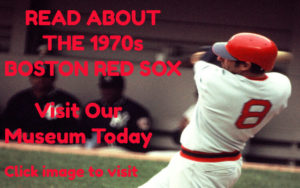The 1977 Boston Red Sox Return To Contention But Come Up A Bit Short
When the Boston Red Sox reached Game 7 of the World Series in 1975 with a core of young players, there was the expectation that great things were underway. Those expectations took a big step back in a disappointment-filled 1976 season. The 1977 Boston Red Sox were able to rekindle the hope, with a strong run at the AL East title, but like so many pre-2004 Red Sox teams, managed to come up just a little bit short.
Boston could score runs, and power was their calling card. The Red Sox hit 213 home runs in 1977. Jim Rice led the way, going deep 39 times and driving in 114 runs. Third baseman Butch Hobson had 30 home runs and 112 RBIs. And though Boston would come to regret trading Cecil Cooper to the Milwaukee Brewers in a deal that included 33-year-old first baseman George Scott, it worked out fine in ’77. Scott hit 33 home runs.
Nor was Boston just a slugging team that couldn’t get on base. They were second in the American League in on-base percentage, and catcher Carlton Fisk had an outstanding all-around offensive season. Fisk finished with a .402 OBP/.521 slugging percentage, while popping 26 home runs himself. Rick Burleson had a .338 OBP, as he played shortstop and hit at the top of the order.
Rightfield was split between Bernie Carbo—who also come from Milwaukee in the Cooper deal, and Dwight Evans. But whomever manager Don Zimmer put out there, it resulted in productivity. Carbo’s numbers were .409/.522, while Evans was at .363/.526, and perhaps the best throwing arm in the game. Even with centerfielder Fred Lynn, having a down year, the hitters were getting it done at Fenway.
And speaking of getting it done…the old veteran, 37-year-old Carl Yastrzemski, was as good as ever. He played left field with brilliance, had a .372 on-base percentage and .505 slugging percentage. Yaz hit 28 home runs and drove in 128 runs, as he furiously chased the World Series ring that eluded him along with the rest of Red Sox Nation.
But a baseball team does not live by offense alone, and Boston had pitching problems. They tried to fix them in the offseason with the splashy free agent signing of reliever Bill Campbell. He saved 31 games in 1977 with a 2.96 ERA, but the staff overall was still eighth in the AL—a killer problem to have against strong pitching staffs from their key rivals, the New York Yankees and Baltimore Orioles.
Fergie Jenkins was the ace of the staff with a 3.68 ERA, but the 34-year-old former Cy Young winner (with the Chicago Cubs) only went 10-10. Ever other starter, including the aging Luis Tiant, was up over 4. Bob Stanley and Mike Paxton were competent out of the bullpen, but there was just no shutdown starter or dominant reliever that this club could rely on.
Boston started the season 10-10 and were 3 ½ games back on May 3, before winning eight of eleven against non-contending AL West teams. The division race was tight early on, with the Sox, Yanks and Orioles all right on top of each other. The Red Sox closed May on a sluggish note, going 6-8 and ending the month 2 ½ games back.
Then they made their move, winning 17 of the first 21 games in June, and the big blow was a weekend series sweep of the Yankees in Fenway Park. This series is remembered for Saturday afternoon, when a nationally televised game saw a dugout confrontation between New York manager Billy Martin and his rightfielder Reggie Jackson turn physical. But don’t overlook how thoroughly the Boston bats unloaded over the weekend.
Boston scored thirty runs in the three-game sweep of their archrival. They hit 12 home runs, and no one was hotter than Yaz. The veteran went 9-for-14, drove in ten runs and hit four home runs in a weekend to remember. The Red Sox’ lead in the AL East grew as large as five games, but a return trip to the Bronx brought them back to earth.
On June 24, a Friday night in New York, Boston had a 5-3 lead and was ready to close out another win. Campbell was on the mound and got the first two outs. Then he gave up a triple to Willie Randolph, a home run to Roy White and the game was lost in extra innings. After losing on Saturday and trailing 4-1 on Sunday, the Red Sox rallied to tie the series finale in the ninth inning. Campbell promptly gave it back in the bottom of the ninth, and Boston was swept.
The Red Sox then dropped three straight in Detroit and three straight in Baltimore, showing how the lack of a rotation stopper left Boston vulnerable to long losing streaks. But even though the division lead had vanished, Boston still got the All-Star break within a half-game of first place.
A soft schedule run of the California Angels, Seattle Mariners and Oakland A’s resulted in an 11-game win streak for the Red Sox over late July and early August, and they built up a lead of 3 ½ games. But a trip to the future AL West champ Kansas City Royals resulted in a sweep, and that started a seven-game losing streak.
While Boston was fluctuating wildly, New York was gaining traction and by Labor Day, the Yanks led by 4 ½ games over the Red Sox and five on the Orioles. Boston, contrary to their image, didn’t fold up at the key moment of the season. They came on strong, with a 22-9 finish. The problem was that New York was too steady, and the head-to-head matchups were done. The Yankees went 20-10 over this same period.
When the final weekend began, the Red Sox and Orioles both trailed the Yanks by three games with three to play. To make things easier for New York, they would play a bad Detroit team at home, while Boston and Baltimore had to play each other. Even though the Yanks lost on Friday and Saturday, the Red Sox knocked the Birds out on Friday, and Baltimore returned the favor on Saturday. Boston’s drive at the top of the AL East was over.
The 1977 Boston Red Sox still won 97 games and provided a lot of entertainment with the muscle of their offense. They were just a little too flawed in the pitching department to be the team that got the good people of New England over the top.


